General Information
Sexing Birds
Some birds are sexually dimorphic (meaning you can tell their sex by physical appearance). The following are ways to determine the sex of your little feathered buddy. For birds that are not sexually dimorphic, DNA SEXING is avaiable to determine sex.
===============================
Sexing budgies
The cere is the stereotypical way to tell sex physically with budgies. Ceres are the flesh above their beak enveloping their nostrils. Females stereotypically have brown or tan ceres (left photo) and males stereotypically have blue ceres (right photo). The color of their ceres do not develop until they are around 6 months of age. However, depending on the budgie's color variety, some can lack pigments to express coloring in their cere and retain pink ceres all their lives (such as the “Inos” [lutinos and albinos] and the dilutes).
 |
 |
Very experienced budgie owners (primarily breeders) can predict sex in "underaged" budgies (that is, well before they reach maturity, at 6 months, the time when the average budgie will develop his/here cere color). CLICK HERE to read how to predict sex of underaged budgies and other tricks to determine sex.
Please note that behavior does not accurately determine sex and anyone that tells you otherwise is misinformed. Males stereotypically do bob heads, preen and feed others more than females, but females do this as well and some do these things just as often as males do.
===============================
Sexing Canaries
We went through great lengths and several books to write an article on sexing canaries and then we hit upon a great site that offers everything in full detail and photos! Who could ask for more?
Read up on how to sex canaries, written by Sebastian Vallelunga, CLICK HERE.
===============================
Sexing cockatiels
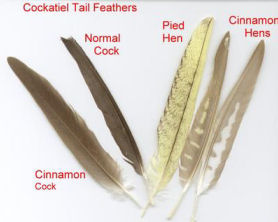
The underside of the tails of males are one solid color whereas females tend to have have bars or stripes (these are called "bands"). Young males also have bands but they loose it when they mature, females retain these bands (see photo above - photo made by Ann ).
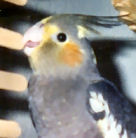 |
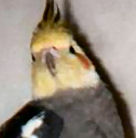 |
Another way to tell sex is by looking at the face (of course this will be difficult depending on the the color variety of the tiel). For the normal greys, females have a light shade of grey and less yellow on their faces (left photo) while males have a darker shade of grey and bright yellow faces (right photo). The yellow in the face does not develop until 6-10 months of age.
===============================
Sexing Finches
There is just too many color varieties in finches, and they each have their own unique physical appearances/features to distinguish sex. This page will only talk about how to sex the most common type of finches - the Zebra Finches.
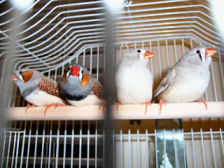
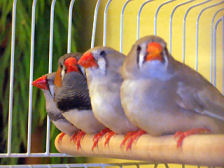
Photos: Two finches on the left are males, two finches on the right are females.
Males have bolder colors than females. They have dark orange beaks and a black bar across their breast. They also have bright orange cheeks and visible white spots on their wings (see top photo).
Females are dimmer in color. They also have orange beaks but do not have a black bar across their breast - however, some do have the occasional black feather on their breast. Females do not have white spots on their wings (see top photo).
===============================
Sexing Lovebirds
Sexing lovebirds are not sexually dimrophic. The only sure way to sex lovebirds is via DNA sexing. To read more about DNA sexing, CLICK HERE.
There are tricks that may predict sex, but some of there have been found to not adhere to the actual sex of the lovebird. Use these tricks with caution and an open mind that they may be wrong and that they are fairly relative so that you would have to have another bird of the opposite sex to compare to:
- Females have broader head, shoulders, and pelvic span than males.
- Females tend to be sturdier and heavier in build
- Remember that behavior does not accurately predict sex. For instance, just because a lovebird is seen to feed another lovebird does not mean that the one feeding is always a male - sometimes females feed others as well.
- Males tend to be bolder in feather colors
===============================
Sexing Parrotlets
Deep blue on the back (the rump) and on the wings (mainly on the primary flight feathers) indicate a male bird. Males also have a brighter face than females and a visible streak of blue behind each eye. Females have a lighter color on their rump and no visible changes in brightness or shades in their faces. Most females have no blue on their wings, however, a species known as Yellow Faces will have blue on their wing but it is much paler than the blue visible on male wings.
